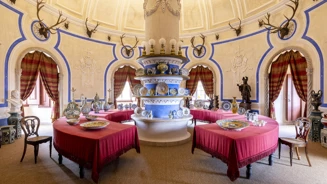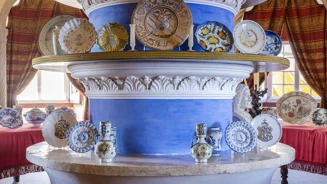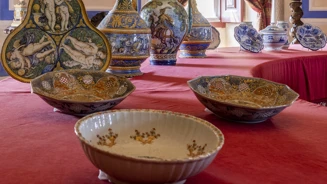Stag Room at the Palace of Pena restored to its original glory and once again showcasing pieces belonging to King Ferdinand II
14 May 2025
The Stag Room at the National Palace of Pena has never been closer to the splendour that characterised it during the time of King Ferdinand II, the monarch who commissioned its construction. Following the conservation and restoration works carried out in 2022, which recovered its original colours – stone tones on the decorative stucco elements and ultramarine blue framing – the room now resumes the exhibition function intended for it by the king himself, and is once again adorned according to the aesthetic choices of the 19th century.
Extensive research conducted ahead of the new museological project revealed that, although the Stag Room was initially designed as the Dining Room of the New Palace and occasionally used as such, around 1876 King Ferdinand II decided to alter its purpose. He transformed it into a space for displaying artworks from his personal collection, particularly ceramic pieces. At a time when both the king and the Countess of Edla were using the palace, the room, along with the chapel and tower, was even opened to a select group of visitors.
The findings from this research formed the foundation for the historically informed reconstruction of the Stag Room, which restores the space’s exhibition function from the time of King Ferdinand II. The reconstitution brings together, for the first time, approximately 70 pieces of ceramics, sculpture and furniture that once belonged to the monarch and were formerly displayed in the Noble Gallery of the Cloister. In more recent times, these objects had been dispersed across other rooms or kept in the Palace reserve, but they are now reunited and on public display, offering insight into the king’s original curatorial intent, which was later maintained, with occasional additions and removals, by his grandson King Carlos.
Amongst plates, jars, pots, plinths, candelabra and stools, the majority of items on display are faience ware, spanning different periods and origins. King Ferdinand II – the Artist King – was an impassioned lover of the arts and an avid collector, who assembled a rich and varied collection of high-quality works. The Stag Room presents a portion of this collection and offers a glimpse into the king’s artistic tastes, extending beyond ceramics alone. The decoration of the space also merits special attention.
The return of comfort through textiles
The museological reconfiguration of the Stag Room began with a focus on the key decorative elements that defined the space, and which remained constant throughout its use in the time of King Ferdinand II. One of the most significant features is the return of the iconic original circular table, crafted in 1861 by carpenter Gregório Casimiro during the ongoing construction of the Palace. At the time, it was permanently covered with a scarlet cloth, which has now been faithfully reconstituted as part of this museological project. As in the 19th century, the table once again serves as a base for the exhibited objects.
Sideboards, central column shelves, lamps, chairs, curtains, matting and carpets complete the setting envisioned by the monarch for this room. All of these elements have returned to the Stag Room, either in their original form or as faithful reconstructions based on the study of the reserve collections, archival inventories and other historical documentation.
The reproduction of the curtains and matting is essential in recreating the sensory experience of this palatial interior, as they contribute not only to the visual richness of the space, but also to its acoustic and thermal comfort. The curtains – in red and gold tones – and their woollen trimmings have been meticulously reconstituted based on preserved examples from the Palace reserve.
The reconstitution of original textiles from the Palace of Pena forms part of an important and innovative project that has already involved seven years of preparatory research. This work includes the analysis of textile collections from both national and international institutions; the identification of historical suppliers, including international firms that once provided goods to the Portuguese Royal Household and to King Ferdinand II and that still operate today; and multiple visits to both national and international palaces. The reproduction of the Stag Room curtains marks the first tangible result of this detailed undertaking, which will continue over the next three years.
The museological refurbishment of the Stag Room is part of a wider project currently underway in the interiors of the National Palace of Pena. The aim is the historical reconstruction of the domestic environments once inhabited by the Royal Family within the monument. To achieve this, thorough historical research has been carried out, supported by documentary sources and period iconography.



